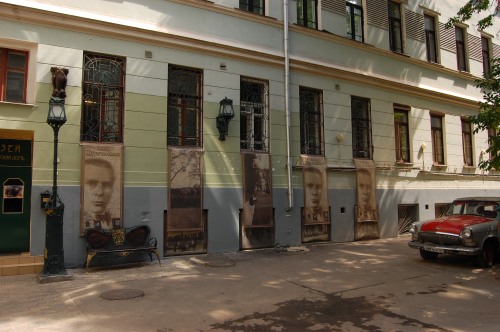
The Bulgakov Apartment and Museum
Presnya is a Moscow region that stretches across the near northwest quarter of the city. The region straddles the Garden Ring from Tverskaya Street in the north to a bend in the Moscow River due west of the Kremlin.
To start at the north end of Presnya, take the Zamoskvoretskaya metro line and exit at the Mayakovskaya station. Find the Garden Ring ( in actuality a wide swath of concrete and cars that sweeps through Moscow) and walk southeast along its south side. As you walk the first block, look for a small courtyard off to the left easily missed as just another one of the multitudes of gated courtyards found in the city. A small sign will tell you that you have found the location of the Bulgakov Apartment and Museum.
Mikhail Bulgakov, counted as one the greatest of all Soviet writers, was born in 1891 in Kiev and lived in this apartment from 1931 until his death in 1940. Because Bulgakov satirized early Soviet life, his works were heavily censored by the Soviet authorities. Some of his literature did not appear until after his death. The small museum preserves photographs, personal belongings, correspondence and writings, and other relics belonging to and concerning the author. Readings and other performances are scheduled within the intimate settings of the apartment. If you are lucky, you may get a glimpse of a large black cat doing it’s best to play the part of Begamot, the “chess-playing, vodka-drinking, pistol-welding”, talking giant cat from Bulgokov’s masterpiece The Master and Margarita.
Returning to the Garden ring and turning left, one needs to walk only a couple of blocks to turn southwest on Malaya Bronnaya Street . One block away from the bustle of the Ring is quiet and leafy Yermolayevksy Lane and Patriarch’s Ponds.
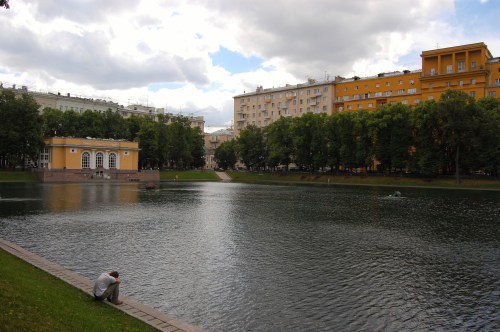
Patriarch's Ponds
One hot spring evening, just as the sun was going down, two men appeared at Patriarch’s Ponds. One of them-fortyish, wearing a gray summer suit-was short, dark-haired, bald on top, paunchy, and held his proper fedora in his hand; black horn-rimmed glasses of supernatural proportions adorned his well-shaven face. The other one-a broad shouldered, reddish-haired, shaggy young man with a checked cap cocked on the back of his head-was wearing a cowboy shirt, crumpled white trousers, and black sneakers.
And so begins Bulgakov’s The Master and Margarita. The Master and Margarita tells the story of the Devil coming to Moscow and causing chaos. It also gives a satirical criticism of Soviet life of the 1930’s. Bulgakov worked on the book until a month before his death in 1940. The book was finally published in heavily censored form in 1967. The complete edition was published in 1973.
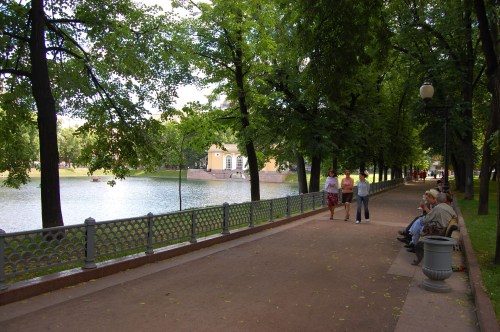
Russians enjoying Patriarch's Ponds.
Patriarch’s Ponds is situated in what is now one of the more up-scale neighborhoods of Moscow. Despite the name, there is only pond. The pond was originally used as a fish farm and for the enjoyment of the estate owner and his guests. Today the park is one of Moscow’s hidden gems and a walk around the pleasant path is well-worth the time.
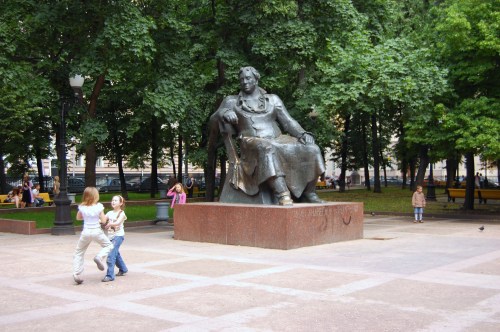
Statue of Krylov.
This statue of Ivan Krylov stands on the northwest side of Patriarch’s Ponds. Krylov (1769-1844) is Russia’s great fabulist.
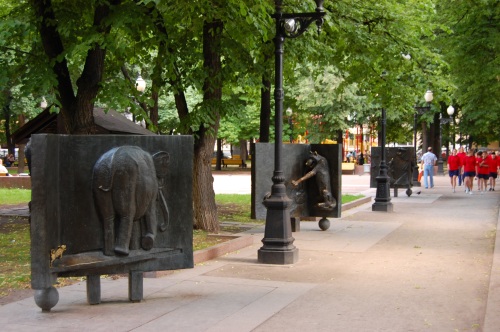
Krylov Fables: Elephant and Pug, The Wolf in the Kennels, and Fox and Crow.
Some of Krylov’s works paralleled those of Aesop and Jean de la Fontaine and others were original. His stories include Fox and Crow, A Little Box, Frog and Bullock, The Oracle, Hermit and Bear, The Peasant and Death, Crow and Fowl, Sharing Up, The wolf in the Kennels, and A Train of Carts. Along with the statue of Ivan Krylov, the northwest side of Patriarch’s Ponds is lined with monuments depicting his works.
Leaving Patriarch’s Ponds and walking south, Yermolayevsky Lane changes to Vspolny Lane which in turn ends at Malaya Nikitskaya. A right turn returns you to the Garden Ring. As you walk along Malaya Nikiskaya, glance into the courtyard of the Tunisian embassy on the right. At one time the embassy compound was the home of the Bolshevik Lavrentiy Beria. Beria lost the power struggle following Stalin’s death and was denounced and executed in 1953.
Turn right when you reach the Garden Ring. Half a block north is the Chekov home.
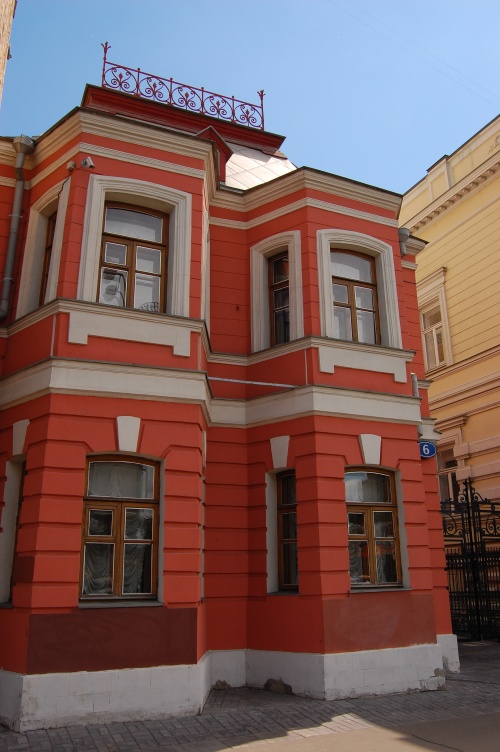
Chekov Home
Yet, for every daring Russian who forged ahead at the beginning of the twentieth century, fifty others retreated into the lengthening shadows of the empire’s twilight, where habit reigned supreme and life moved in a circular course that led from no place to nowhere. Afraid of what lay ahead, such men and women hoped to stay in the present, where a shield of monotonous banality cut them off fomr the furture and limited their vision to the familiar, the tried, and the true. As the chronicler of the bittersweet world in which such timed people lived, Anton Chekov recreated the quiet, boring shelter thta shielded modern life from everything that made it interesting and worthwile. In hundreds of short stories and almost a dozen plays, this greatest of end-of-century writers captured the mood of mounful longing that assured Russia’s timid victims of progress that their way of life would never change.
from Between Heaven and Hell: The Story of a Thousand Years of Artistic Life in Russia by W. Bruce Lincoln
Anton Chekov (1860-1904) is considered to be one of the worlds greatest playwrites and writers of short stories. The author resided in this home from 1886-1890.
To cross the Garden Ring you will have to find one of the pedestrian ways that cross underneath the busy boulevard. Once you have emerged on the west side, walk south. Look up and to the right to see the Kudrinskaya Square Building, one of the Stalinist skyscrapers known as the Seven Sisters. Just before the U.S. Embassy you will find the home of Feodor Chaliapin.
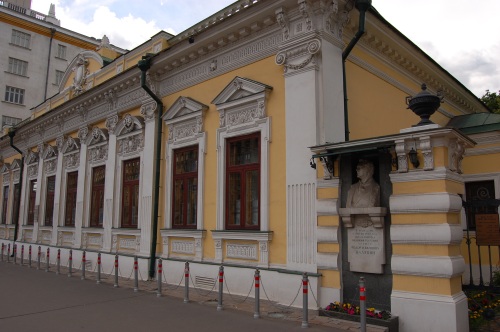
Shalyapin Home, Moscow, Russian Federation
Feodor Chaliapin (1873-1938) was a famous Russian and Soviet opera singer. The career of this singer with a massive bass voice straddled both the Tsarist and Soviet regimes.
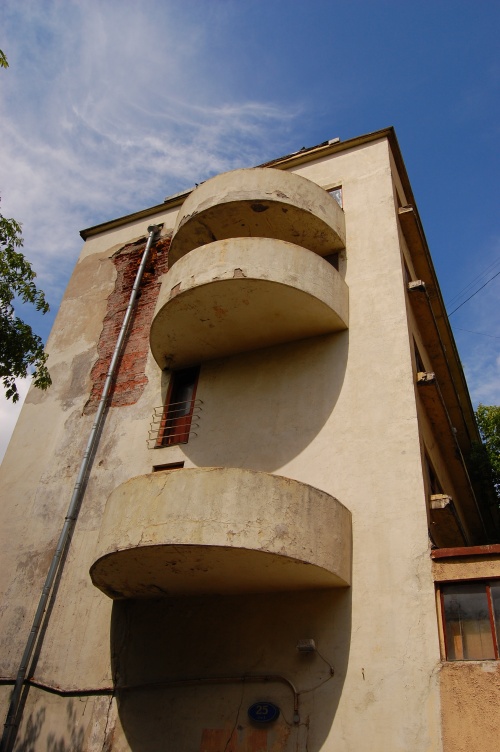
Narkomfin, Moscow, Russian Federation
A narrow alley off of the Garden Ring leads you behind the Shaliapin home, along the back side of the U.S. Embassy, and to one of my favorite buildings in Moscow, the House of Narkomfin. Narkomfin was built between 1928-1930 for the workers of the People’s Commissariat of Finance. Designed by Moisei Ginzburg, Ignaty Milinis, and engineer Sergei Prokhorov, this fine example of Constructivist architecture was meant to encourage communal living. Narkomfin was an influence on Le Corbusier in his design of Unités des Habitation, built between 1946 and 1952 in Marseille. Unfortunately, soon after its completion Narkomfin failed as a communal building, though it is still occupied today. Efforts have been made to restore the building; however, as of 2009 it was in severe distress and continued decay.
Walk downhill from the Narkomfin building on Maliy Kopyushkovsky Lane, then turn left and continue downhill toward the Moscow River on Kopyushkovskaya Street. Across the street on the right is located the Russian White House, the government building of the Russian Federation and the office of Vladimir Putin.

White House, Moscow, Russian Federation
It was in front of the White House that Boris Yeltsin climbed aboard a tank to during the 1991 coup. Whether because of the craftiness of Yeltsin or the incompetence of the coup leaders (or both), on the morning of August 19th Yeltsin managed to avoid detainment and made his way to the White House where he defied the coup for two days. Those inside of the White House fully expected to die in defense of the building, especially on the night of the 20th. But on the 21st the coup collapsed and troops withdrew from Moscow.
